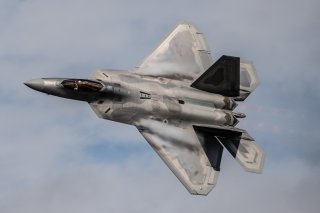Can Data Integration Help the U.S. Fight at the Speed of Light?
Given the integrated nature of warfare, development and prototyping efforts need to be integrated as well.
The Pentagon is accelerating its efforts to uncover paradigm-changing technologies and quickly get promising systems onto the battlefield. Given the integrated nature of warfare, development and prototyping efforts need to be integrated as well, a key reason why the Pentagon is increasing multi-domain collaboration with its industry partners.
Raytheon, for example, has in recent years formed a special “integrated” unit called Department 22, which includes a wide array of researchers, scientists, and weapons development experts closely collaborating to optimize and accelerate technological progress.
While Raytheon has for many years worked on various research and development initiatives to identify paradigm-changing technologies, Department 22 connects otherwise distinct business groups within Raytheon to form a broader integration effort.
“We've always had an advanced concepts and technology group focused on creating the innovation to continue building the core foundational technologies for the company. … Then, about two years ago, we integrated with another part of the business in [Raytheon] that specializes in air and space constellation management with expertise in ground systems software and data management algorithms. We take data that we generate, which has now become voluminous, and enable its use across the battlefield as close to near real-time as possible,” Paul Meyer, the president of Department 22, told the National Interest in an interview.
The key is the integration of stove-piped areas of data collection and analysis in order to process, assess, and transmit at the point of collection in seconds, allowing systems to share an informed, integrated picture to decision-makers. The concept is to quickly assess a number of critical variables in relation to one another, reduce latency, and efficiently expedite the transmission of time-sensitive information.
“We start with decomposing the mission architecture up front, providing the level of integration parameters needed to refine our designs with more system engineering rigor than we have in the past. The problem statement we are solving is removing the manual dependency inherent in today’s combat aircraft and data management centers on the ground. They are manpower intensive systems, each with their own data sources that take more time to manually process the data, prosecute it through their command structure, and execute military mission objectives,” Meyer said.
Breakthroughs in artificial intelligence (AI) and autonomy can help enable this process, allowing unmanned systems to perform data organization and analysis at the point of collection, streamlining the transmission of time-sensitive combat data across a multi-domain force in real-time.
“As data comes together and can be appropriately shared to all users at the same time or when needed, applying AI and machine learning algorithms in conjunction with resource management software, I can now leverage the content of all sensors in the network and essentially mesh their combined input to find, fix, track, target, engage, and assess, or what the DoD calls F2T2EA,” Meyer added. “Leveraging our knowledge of current and next-generation multi-function sensors, we present a much more integrated data product to the customer.”
Kris Osborn is the defense editor for the National Interest. Osborn previously served at the Pentagon as a Highly Qualified Expert with the Office of the Assistant Secretary of the Army—Acquisition, Logistics & Technology. Osborn has also worked as an anchor and on-air military specialist at national TV networks. He has appeared as a guest military expert on Fox News, MSNBC, The Military Channel, and The History Channel. He also has a Master's Degree in Comparative Literature from Columbia University.
Image: DVIDS.

